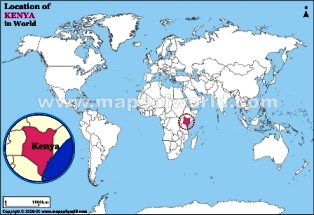Kenya Location in Africa
Need information about Kenya Location in Kenya? Here is the page for you. The Republic of Kenya straddles the equator; indeed it is almost bisected by it.
Its land area of 582,644 square kilometers is roughly the size of France. Almost all of the country is scenic.
Within its borders lies a world in microcosm, containing almost every known landform from glacial ice to arid desert, mountain massifs to rich savannahs, large lakes and dense forests.
Variations in altitude are extreme and so too are the contrasts in climate. The country, which shares common borders with five nations - Tanzania to the south, Uganda in the west, Sudan and Ethiopia in the north and Somalia in the east - is shaped like a harp.
Its boundaries have scant regard for ethnic considerations, and are the result of the sharing out of 'spheres of influence' by the European powers in the 17th century.
Kenya has four distinct geophysical features. Of these, the Great Rift Valley - the massive fracture in the earth's surface, which runs 5000 kilometers from Jordan in the north to Mozambique in the south - is perhaps the most outstanding.
Within the Rift Valley, there is a necklace of eight lakes some fresh and some alkaline where birdlife is never less than stunning.
Other Pages of Interest
Kenya Hotel Forum |
Jobs in Kenya |
Kenya in Africa |
Kenya Business |
Kenya Coffee |
Kenya Deals |
Kenya Entertainment Centres and Clubs |
Kenya Events |
Kenya Flag Meaning |
Frequently asked questions About Kenya |
Kenya Medical Health Services |
Kenya Police |
Kenya Population |
Kenya Real Estate Management |
Kenya Recipes Forum |
Kenya Revenue Authority |
The great concentrations of flamingo at Lake Nakuru, often numbered in millions, led the celebrated ornithologist Roger Tory Peterson to describe them as 'the most fabulous bird spectacle on earth'.
Scores of extinct volcanoes dot the floor of the Rift casting their shadows over the lakes and creating in places a savage lunar landscape.
The second of these geophysical features are the central highlands. These spread like a giant green mantle around three mountain ranges that dominate central Kenya - Mount Kenya, the Aberdares and the Mau. This is an area of rich agricultural land and dense forests.
The principal cash crops are coffee and tea but lately horticulture and floriculture have come to the fore providing fruit, vegetables and flowers for the supermarkets of Europe.
Many of these crops are grown in smallholdings providing a mosaic of diverse greens; other large producers include organizations such as Homegrown Kenya.
Central highland is a region of restful scenery, bracing air and ebullient human activity.
A third region contains the vast arid and semi-arid areas in the north and east of Kenya, which occupy nearly two thirds of the nation's land area.
Served only by the most meager rainfall, these lands provide an existence for hardy nomads who number fewer than one twelfth of the national population of about 31 millions.
The awesome ruggedness of this terrain of thorn scrub, lava rock and scorching sand is punctuated by occasional forest crowned mountain peaks such as Marsabit, Mount Kulal, Mount Nyiru and the Ndoto Mountains.
These cloud forests, nurtured by mist rather than rain, are home to wildlife; elephants carrying the largest ivory in East Africa are found on Marsabit Mountain.
The last of the main geophysical features is the Indian Ocean coastline - a tract 480 kilometers in length and which reaches inland between16 and 30 kilometers.
Fringing the Indian Ocean are long stretches of idyllic, silver-sanded beaches shaded by waving palms.
A coral reef runs almost the entire length of the seaboard creating a spectacular underwater world and protecting the shoreline and the inland waters from storm and shark. This, then, is Kenya, a land where nature was more than generous.
Recent Articles
-
Garam Masala Appetizers ,How to Make Garam Masala,Kenya Cuisines
Sep 21, 14 03:38 PM
Garam Masala Appetizers are originally Indian food but of recent, many Kenyans use it. Therefore, on this site, we will guide you on how to make it easily. -
The Details of the Baruuli-Banyara People and their Culture in Uganda
Sep 03, 14 12:32 AM
The Baruuli-Banyala are a people of Central Uganda who generally live near the Nile River-Lake Kyoga basin. -
Guide to Nubi People and their Culture in Kenya and Uganda
Sep 03, 14 12:24 AM
The Nubians consist of seven non-Arab Muslim tribes which originated in the Nubia region, an area between Aswan in southern








New! Comments
Have your say about what you just read! Leave me a comment in the box below.